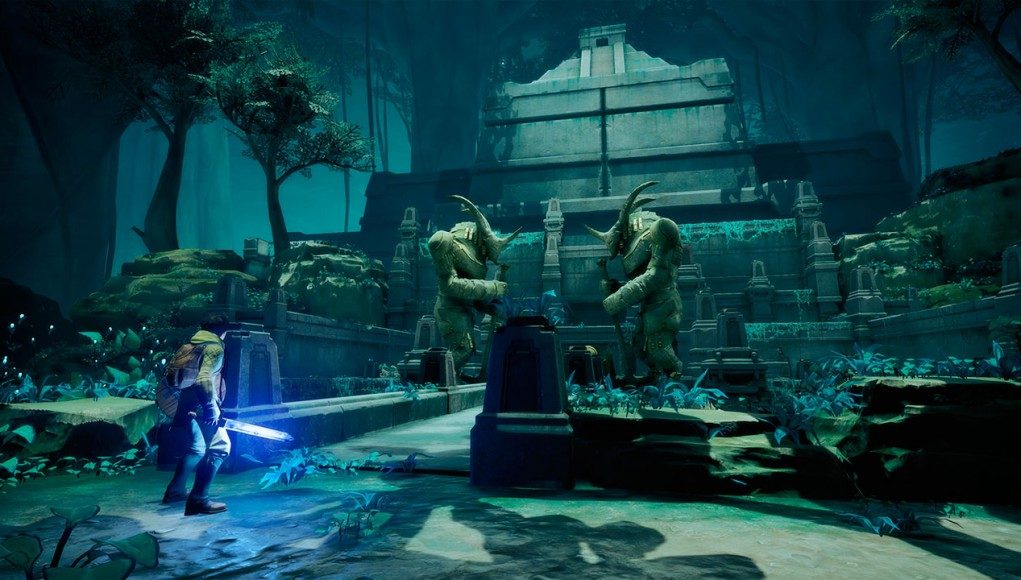 Gunfire Games’ Chronos is an atmospheric RPG with over 10 hours of action and adventure, and it uses a satisfying combat game mechanic that’s very similar to their Herobound: Spirit Journey on the Gear VR. Chronos had a lot of buzz from GDC as being one of the more compelling launch titles for the Oculus Rift, and the promise of 10-12 hours worth of gameplay has many people looking forward to getting immersed within a grand adventure reminiscent of the Legend of Zelda. I caught up with developer Ben Gabbard at GDC talking about some of the gameplay design and VR design principles that they implemented with Chronos & Herobound: Spirit Champion
Gunfire Games’ Chronos is an atmospheric RPG with over 10 hours of action and adventure, and it uses a satisfying combat game mechanic that’s very similar to their Herobound: Spirit Journey on the Gear VR. Chronos had a lot of buzz from GDC as being one of the more compelling launch titles for the Oculus Rift, and the promise of 10-12 hours worth of gameplay has many people looking forward to getting immersed within a grand adventure reminiscent of the Legend of Zelda. I caught up with developer Ben Gabbard at GDC talking about some of the gameplay design and VR design principles that they implemented with Chronos & Herobound: Spirit Champion
LISTEN TO THE VOICES OF VR PODCAST
Audio PlayerChronos uses a unique third-person perspective camera that’s different than the approach taken by Lucky’s Tale in that it’s locked into place, and it cuts between rooms as you explore a labyrinth that has many puzzles to solve and enemies to battle. They decided to deliberately violate film’s 180-degree rule, which draws an imaginary line between the middle any given shot and the camera doesn’t usually cross this line as the director cuts between shots. This is a language of 2D film that helps the audience preserve the spatial relationships between the characters within a scene.
But with VR, there’s no need to orient yourself in 3D space because you’re already immersed within another world, and so Gunfire Games wanted to have more freedom to creating maps that weren’t artificially constrained by this fixed perspective. They use the continuity of being able to see the main character as you move between rooms in order to help you orient yourself to the spatial relationship between the different rooms, and how they’re connected to each other. This deliberate violation of the 180-degree rule is a really interesting development in the language of virtual reality, and one that I think works out pretty well — even if it may be a little disorienting to people at first, especially people with a filmmaking background.
Gunfire Games follows the 180-degree rule within Herobound: Spirit Champion, and my recollection of playing the game was that I had the perspective of a security camera always looking north. But my recollection of playing Chronos was that I still had a somewhat distant perspective of the action, but that I was more immersed within their world.
One advantage of violating the 180-degree rule is that it does provide a bit of a cognitive gap that caused me to stop, re-orient myself, and really take in the entire scene. The art direction in Chronos is stunning, and there’s a lot to look at and take in. Gunfire Games seems to have created a pacing in the game that is slow enough where you can take the time to really appreciate this imaginal world that they’ve created.
Chronos is a Oculus Rift launch title rated as comfortable, and will be selling on the upper end of the price scale at $49.99. It feels like one of the most complete adventure games available on the Rift at launch, and if you enjoyed the Herobound: Spirit Journey series on the Gear VR, then you’ll find a lot to love within Chronos. If Luckey’s Tale is the Super Mario Brothers of VR, then Chronos just might be the Legend of Zelda of VR.
Here’s the Chronos Reveal Trailer that was released 9 months ago. The camera position in this trailer are a little closer to the ground and have more movement than what is in the final game.
Here’s a bit of the Chronos combat gameplay, again with the third-person camera placed closer to than the ground than what was shown off at GDC:
Become a Patron! Support The Voices of VR Podcast Patreon
Theme music: “Fatality” by Tigoolio







